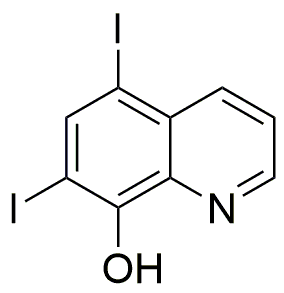5,7-Diiodo-8-hydroxyquinoline is widely utilized in research focused on:
- Antimicrobial Agents: This compound is effective against various bacteria and fungi, making it valuable in developing new antimicrobial treatments.
- Fluorescent Probes: Its unique structure allows it to be used as a fluorescent probe in biological imaging, aiding researchers in visualizing cellular processes.
- Analytical Chemistry: It serves as a reagent in analytical methods for detecting metal ions, enhancing the accuracy of environmental and industrial testing.
- Pharmaceutical Development: The compound's properties are explored in drug formulation, particularly in targeting specific diseases due to its bioactive nature.
- Material Science: Its stability and reactivity make it suitable for developing new materials, including coatings and polymers with enhanced properties.
General Information
Properties
Safety and Regulations
Applications
5,7-Diiodo-8-hydroxyquinoline is widely utilized in research focused on:
- Antimicrobial Agents: This compound is effective against various bacteria and fungi, making it valuable in developing new antimicrobial treatments.
- Fluorescent Probes: Its unique structure allows it to be used as a fluorescent probe in biological imaging, aiding researchers in visualizing cellular processes.
- Analytical Chemistry: It serves as a reagent in analytical methods for detecting metal ions, enhancing the accuracy of environmental and industrial testing.
- Pharmaceutical Development: The compound's properties are explored in drug formulation, particularly in targeting specific diseases due to its bioactive nature.
- Material Science: Its stability and reactivity make it suitable for developing new materials, including coatings and polymers with enhanced properties.
Documents
Safety Data Sheets (SDS)
The SDS provides comprehensive safety information on handling, storage, and disposal of the product.
Product Specification (PS)
The PS provides a comprehensive breakdown of the product’s properties, including chemical composition, physical state, purity, and storage requirements. It also details acceptable quality ranges and the product's intended applications.
Certificates of Analysis (COA)
Search for Certificates of Analysis (COA) by entering the products Lot Number. Lot and Batch Numbers can be found on a product’s label following the words ‘Lot’ or ‘Batch’.
*Catalog Number
*Lot Number
Certificates Of Origin (COO)
This COO confirms the country where the product was manufactured, and also details the materials and components used in it and whether it is derived from natural, synthetic, or other specific sources. This certificate may be required for customs, trade, and regulatory compliance.
*Catalog Number
*Lot Number
Safety Data Sheets (SDS)
The SDS provides comprehensive safety information on handling, storage, and disposal of the product.
DownloadProduct Specification (PS)
The PS provides a comprehensive breakdown of the product’s properties, including chemical composition, physical state, purity, and storage requirements. It also details acceptable quality ranges and the product's intended applications.
DownloadCertificates of Analysis (COA)
Search for Certificates of Analysis (COA) by entering the products Lot Number. Lot and Batch Numbers can be found on a product’s label following the words ‘Lot’ or ‘Batch’.
*Catalog Number
*Lot Number
Certificates Of Origin (COO)
This COO confirms the country where the product was manufactured, and also details the materials and components used in it and whether it is derived from natural, synthetic, or other specific sources. This certificate may be required for customs, trade, and regulatory compliance.


